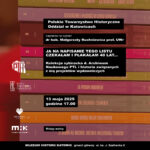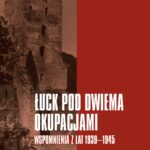See below for the English version.
Kolekcja ta jest jednym z największych zbiorów tego typu w Polsce. Obecnie liczy 977 j. a.. Oprócz wspomnieniowych prac autorskich w skład zbioru wchodzą kwestionariusze badawcze dotyczące deportacji do ZSRR wypełnione w latach 90. XX w., a także dokumenty urzędowe, zdjęcia, listy, rysunki. Jest tu również nieco opracowań naukowych. Zasadniczy zbiór dotyczy losów osób deportowanych z Polski Wschodniej w głąb ZSRR w latach 1940-1941, oraz więzionych w radzieckich obozach różnego typu w latach 40. i 50. XX w.
Niektóre materiały opowiadają o zesłańcach XIX w., Polakach-obywatelach radzieckich represjonowanych w latach 30. XX w., Polakach przesiedlonych na zachód z ówczesnej Polski Wschodniej po zmianie granicy w 1944 r., czy współcześnie żyjących na Dalekim Wschodzie potomkach polskich zesłańców czy przesiedleńców.
Bibliografia komentowana ma służyć studentom, badaczom, publicystom, nauczycielom i generalnie wszystkim zainteresowanym, ułatwiając im wstępną selekcję materiału. Na jej podstawie powstała także baza elektroniczna kolekcji, która umożliwia wyszukiwanie materiałów on-line (dostępna na stronie PTL). Z jej pomocą czytelnik może wstępnie poznać bogatą i zróżnicowaną zawartość kolekcji.
Bibliografia składa się z rozbudowanego opisu poszczególnych jednostek archiwalnych tworzących kolekcję. Opis podzielono na dwie części. W pierwszej zamieszczono podstawowe informacje – nazwisko autora, tytuł pracy (oryginalny lub nadany przez archiwistę), sygnatura, charakterystyka zewnętrzna tekstu (rękopis/maszynopis, kopia/oryginał, liczba stron, data powstania). Odnotowano tu również materiały dodatkowe załączone do tekstu (zdjęcia, dokumenty) i inne niezbędne uwagi o nim.
Część drugą stanowi krótkie streszczenie wspomnień, którego wielkość zależała od objętości pracy i jej szczegółowości. Podano cezury, między którymi rozgrywa się główna część wspomnień. W streszczeniu zaznaczono problemy, które we wspomnieniach zostały obszerniej przedstawione. Starano się również, na ile to było możliwe, przekazać podstawowe informacje o autorze (data urodzenia lub wiek w momencie wybuchu wojny, deportacji lub uwięzienia, sytuacja rodzinna, miejsce zamieszkania w owym czasie z uwzględnieniem podziału administracyjnego Polski przedwojennej).
Zaznaczono także główne etapy zesłańczego losu z podaniem nazw miejscowości pobytu i dat. W niektórych przypadkach znalazły się również informacje o dalszym życiu bohaterów wspomnień. W przypadku materiałów wydanych później drukiem zrezygnowano z ich streszczania, ograniczając notę do podania zapisu bibliograficznego publikacji i ram chronologicznych narracji.
The Siberian deportees’ collection from the Archives of the Polish Ethnological Society in Wrocław. Annotated bibliography
This collection is one of the biggest of its kind in Poland. It is stored in the Jan Czekanowski Library of the Polish Ethnological Society (Polskie Towarzystwo Ludoznawcze; PES) in Wrocław. The collection came into existence in 1988, when the Polish Ethnographical Society and the editorial staff of the Literatura Ludowa (Folk Literature) magazine announced a contest for memoirs and materials about the Poles forcibly sent to the Soviet Union in the years 1939-1956. According to historians, the Soviet repressions affected at least half a million Poles, citizens of the pre-war Polish state, as well as tens of thousands members of the Polish minority in the USSR. In the communist era, this was a political taboo subject. It was not discussed in public, neither was it taken up by historians.
The situation changed only at the end of the 1980s, when communism was already falling. The contest aroused great public interest. Three hundred and forty-three competition entries were sent in from Poland and western countries. In April 1990, a jury presided over by Prof. Czesław Hernas – chief editor of Literatura Ludowa and professor at the University of Wrocław – gave the first-place prize to Jan Prorok, and second-place prize to Leonard Perepeczko from Pasłęk. Five third-place prizes were awarded (Czesław Bazan from Wrocław, Stanisław Dakiniewicz from Łódź, Fr. Albin Jałocha from Kraków, Zofia Orłowska from Chełm and Anna Sobota from Pruszków), as well as a number of honourable mentions. Some of the entries were later published as a part of a series “Exiles Library” (chief editor: Antoni Kuczyński). The remaining ones, however valuable most of them were, in the form of manuscripts or typescripts today form this collection.
In the years that followed, the PES were given hundreds of accounts and materials. At the moment, almost 980 archival units are incorpo- rated into the collection. Apart from individual authors’ accounts, the collection includes also research questionnaires on deportations to the USSR completed in the 1990s, as well as official documents, photos, letters, drawings, and a few research studies on the subject. The core of the collection is about the fate of people deported deep into the USSR from Eastern Poland in the years 1940-1941, and of prisoners of various camps in the 1940s and 1950s. Some materials talk about 19th-century deportees, Poles who were Soviet citizens oppressed in the 1930s, Poles resettled from the Eastern Poland to the western parts of the country after the change of borders in 1944, or the descendants of Polish depor- tees and displaced persons, now living in the Far East.
The aim of this annotated bibliography is to help students, researchers, publicists, teachers and, in general, all those interested in the subject, with preliminary selection of information. It will also be a base for electronic version of the collection, thus enabling on-line search of information (it will be available on the PES’s website). The collection is diverse. Its contributors came from different backgrounds, received different edu- cation, were of different sex, professions and social standing. Usually they were members of the masses of “typical” deportees or prisoners, and told their stories in this way.
In the collection one can find both great-volume typewritten accounts and letters consisting of only one page. Mostly, the texts were written at the turn of the 1980s and 1990s. However, some authors had created their accounts back in the com- munist times, with no publication in mind, just for their families. Quite often, the authors do not rely only on their own memories, but also on what their families and friends remember, on documents that lasted, on notes and impressions written down after their return to Poland. A considerable number of the authors were children at the time of the events, and their accounts are offered exactly from this perspective.
The form of the collected testimonials varies to include objects such as home-made quasi-books, bound volumes, illustrations with author’s comments, notebooks filled with hand writing, and letters the length of one page. Memoirs were usually accompanied by originals or photo- copies of various documents, photos, drawings. Sometimes one can also. encounter plans of settlements or camps the authors of the accounts were sent to. The collection includes also poems and songs written in the USSR and back in the country, letters from exile, and even diaries kept despite the unfavourable conditions.
Some authors concentrate almost exclusively on their own painful experiences. However, the testimonials give also a picture of the Soviet society, its institutions and repression authorities, and lifestyle. There are, too, many accounts describing contacts the deportees established with other prisoners of different nationalities or with the local population of Siberia and Kazakhstan. The collection is full of accounts depicting work in camps and prisons, and the daily life conditions (food, hygiene, clothing, but also religious life and interpersonal relationships).
The authors, to the extent it was possible for them, tried to relate their psychical condition in those times, how they felt and what they thought. More often than not, they tried to stay objective in their assessment of the environment they found themselves in. They scrupulously noted both acts of violence, and acts of kindness they witnessed or experienced in the depths of the USSR. Poles did their best to adjust and get used to the situation, which, however, did not mean abandoning their identity. Reading their memoirs, one gets a heart-breaking picture of a struggle for survival despite ruthlessness of the authorities, human animosity, severe climate, one’s own feeling of impotence and hopelessness of the situation. Many of the accounts give also a short description of homecoming and what happened afterwards in their lives back in Poland. One of the great advantages of the accounts from this collection is that they are authentic and emotionally charged. In many instances, they give a unique chance to find out about facts not recorded in the official documents available in archives.
Worth noticing in connection with these materials is also one more aspect related to the times of their origin. In most cases, they were written down outside the official canon of memory and remembrance promoted in the communist Poland at the time. Only after the political breakthrough of 1989 was a model of “Siberia deportations narrative” developed, becoming a standard for creating this kind of accounts. Compiling this bibliography – apart from research purposes – was also a way of commemorating and thanking all those people who decided to record their tragic life stories and share them with others.
The bibliography contains detailed description of each archival unit from the collection. The description is divided into two parts. The first one includes basic information such as name of the author, title of the text (original or given by the archivist), reference number, text format (handwritten/typed, copy/original, number of pages, date of origin). Also additional materials appended to the text are listed here (photographs, documents), as well as any other essential remarks concerning it.
The second part is a concise summary of the account; its size depends on the length and extensiveness of the original material. Then, time frame of the main events is given, and the main issues covered in the text in more detail are outlined. The summary also attempts to present – to the extent it is at all possible – some basic data about the author (date of birth or age at the time the war started or at the time of deporta- tion or imprisonment, family situation, place of residence at that time, taking into account the administrative division of the pre-war Poland). Deportation is divided into main phases; the names of places of stay and dates, as well as – in some cases – information on the post-deportation fate of the authors is provided. In case of the materials that were later published in a printed form, they are not summarized, and the entry in such instances is limited to bibliographical information and chrono- logical data.
Transl. by Michał Sikora







Comments by admin